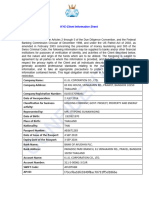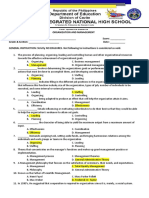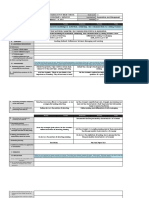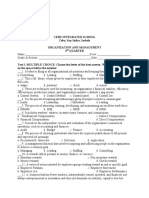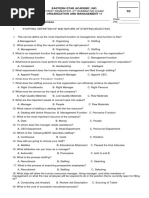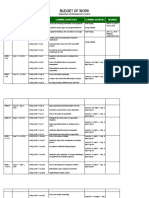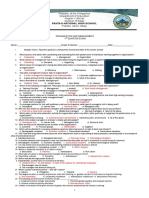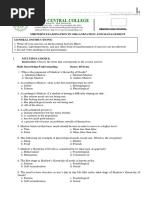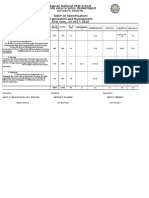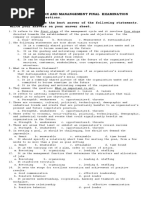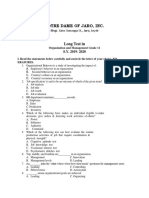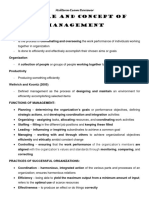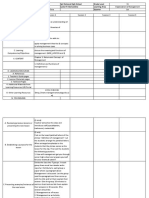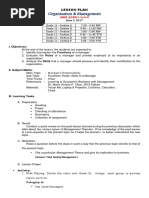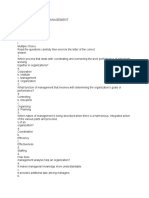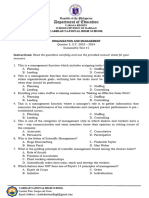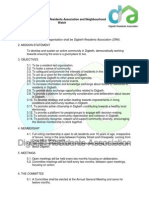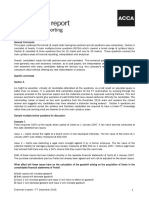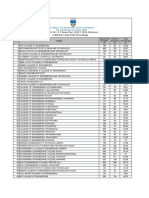Organization and Management 1st Quarter
Organization and Management 1st Quarter
Uploaded by
Glenda ApostolCopyright:
Available Formats
Organization and Management 1st Quarter
Organization and Management 1st Quarter
Uploaded by
Glenda ApostolOriginal Description:
Copyright
Available Formats
Share this document
Did you find this document useful?
Is this content inappropriate?
Copyright:
Available Formats
Organization and Management 1st Quarter
Organization and Management 1st Quarter
Uploaded by
Glenda ApostolCopyright:
Available Formats
Republic of the Philippines
DEPARTMENT OF EDUCATION
Region I
PANGASINAN DIVISION II
SAN QUINTIN NATIONAL HIGH SCHOOL
San Quintin, Pangasinan
ORGANIZATION AND MANAGEMENT
1ST QUARTER EXAM
Name: Year & Section: Score:
I. Multiple Choice. Read the questions carefully then encircle the letter of the correct answer.
1. Which process that deals with coordinating and overseeing the work performance of individuals working together in organizations?
a. Corporation b. Institute c. Management d. Organization
2. What function of management that involves with determining the organization’s goals or performance?
a. Controlling b. Discipline c. Organizing d. Planning
3. Which nature of management is being described when there is a harmonious, integrated action of the various parts and processes of an
organization?
a. Coordination b. Efficiency c. Effectiveness d. Staffing
4. How does management analysis help an organization?
a. It makes managerial knowledge more understandable. c. It provides additional task among managers.
b. It gives pressure to the manager in attaining their aims. d. None of the above
5. Who is the father of Scientific Management?
a. Frederick Taylor b. Joseph Muran c. Max Weber d. W. Edwards
6. Which of the following management Philosophy focuses on the satisfaction of customer’s need and expectation?
a. Deming Principle b. Management c. product d. Total Quality Management
7. What do you call of an individual engage in management activities?
a. Customer b. Employer c. Manager d. Spokesperson
8. The organization’s chairman or chairwoman, chief executive officer, president, managing director and other high-ranking company
executive are classified to what managerial level?
a. Frontline level management c. Middle level management
b. Lower level management d. Top level management
9. If a manager perform his task with proficiency and use his expertise, what type of managerial skill is being used?
a. Conceptual b. Human skills c. Technical skills d. Managerial skills
10. Who are also known as operational managers and responsible for supervising the organization day to day activities?
a. Front line or lower level managers b. Middle level managers c. Top level managers d. None of the above
11. Which refers to the factors/elements outside the organization which may affect, either positively or negatively the performance of an
organization?
a. Environmental scanning b. External business environment c. Internal business environment d. All of the above
12. Which skills enable managers in all levels to relate well with people?
a. Conceptual skills b. Human skills c. Managerial skills d. Technical skills
13. Who are likely to be affected by the activities of the organization?
a. Customer b. Pressure groups c. Stakeholders d. Suppliers
14. Which will be affected if a company postpone expansion plans because of so high of bank loan interest?
a. Demographic situations b. Economic situations c. Sociocultural situations d. Sociocultural situations
15. The Food and Drug Administration pressure some department store to stop selling of beauty products containing lead is an example of what
environmental forces?
a. Individual pressure b. Managerial decisions c. Pressure Group d. Technological situations
16. A situation wherein food companies make sure that the food they offer are low in cholesterol to avoid losing of customers.
a. Demographic situations b. Economic situations c. Sociocultural situations d. World and ecological situations
17. It is one of the most structured and used planning method to evaluate a business venture.
a. Business prediction b. Competitive mindset c. PEST d. SWOT analysis
18. Which is valued by members of a Filipino society?
a. Masculinity b. Feminity c. Individualism d. Risk takers
a. Feminity b.
19. What type of culture is being practiced if people tend to do one thing at a time?
a. Polychronic cultures b. Discipline c. Individualism d. Monochronic cultures
20. Which indicate the high power distance?
a. Subordinates use the name or nickname of the boss.
b. Using the terms “ Sir and Madam “ to refer to the superior by subordinate employees
c. The managers are risk takers.
d. The managers are afraid of taking risk.
21. Which country characterized the “ I and Me” culture?
a. Mexico b. Philippines c. Thailand d. America
22. The degree to which a society emphasizes short-term thinking vs. greater concern for the future or long term thinking.
a. Time orientation b. Uncertainty Avoidance c. Individualism-Collectivism d. Masculinity-Femininity
23. The following are the function of MDGs except ________________.
a. Eradicate extreme hunger and poverty c. Promote gender equality and empower women.
b. Achieve universal primary education d. Macroeconomic Policy
24. It refers to increase in the given amount of goods and services produced by the country’s earning.
a. Economic development b. Economic growth c. Inclusive growth d. None of the above
25. Which are not included in economic development phases?
a. Economic growth c. Improvement of the Human Development Index
b. Globalization awareness d. Availability of the benefits provided by Science and Technology
26. Who was the first development economist?
a. Adam Smith b. Henry Fayol c. Joseph Muran d. W. Edwards Deming
27. A business organizational where the employees continuously work on projects assigned to them?
a. Open business organization c. Team Structure
b. Project business structure d. Virtual business organization
28. Which of the following is a characteristic of boundary-less business organization?
a. It is made up of separate business units. c. Its design eliminates vertical, horizontal, or external boundaries.
b. It is easy to manage because of their simple form. d. Flexible design and the employees continuously works on project assigned to them
29. It is a business organizations designed for the purpose of achieving their organization’s mission vision, goals, and objectives and
maintaining their organizational stability through income generation and profit-making activities.
a. Flexible business organization c. Profit business organization
b. Non-profit business organization d. Simple business organization
30. How important is planning in a business organization?
a. It reduces uncertainty. c. Proper coordination of activities will minimize wastes.
b. It provides direction to organization. d. All of the above
31. It refers to the identification of targets or desired ends that management wants to reach.
a. Goal-setting b. Organizing c. Planning d. All of the above
32. Which of the following plan that go beyond three years?
a. Directional plans b. Long-term plans c. Short-term plans d. Specific plans
33. Which of the following is a level of management that refers to a set of procedures for changing or transforming broad strategic goals and
plans into specific goals and plans that are applicable and needed in one unit/portion of the organization.
a. Lower Level b. Middle-Level c. Top Level d. None of the above
34. Which of the following is involves in identifying the specific procedures and processes required at the lower levels of the organization?
a. Operational planning b. Strategic planning c. Strategic planning d. None of the above
35. What level of manager is responsible for the organization’s strategic planning that involves making decisions about the organization’s long-
term goal and strategies?
a. Lower Level manager b. Middle-Level manager c. Top Level manager d. None of the above manager
36. A plans that are ongoing and provide guidance for different activities done repeatedly.
a. Benchmarking b. Comprehensive c. Forecasting d. Standing
37. Which of the following is an attempt predict what may happen in the future?
a. Benchmarking b. Contingency plan c. Forecasting d. Scenario Planning
38. Mathematical calculations and statistical analyses of surveys/researches are used in?
a. Contingency b. Qualitative c. Quantitative d. Participatory
39. A type of decision that repetitive and can be handled using a routine approach.
a. certainty decision b. participatory c. structured decision d. uncertainty decision
40. The following are the importance of organizing in business companies except
a. There will be a division of labor.
b. Bring harmonious relations among individuals and work group
c. With effective organizing, goals and objectives will all go to waste
d. Different skills and work activities will coordinate with one another for a common end.
41. It involves assigning tasks to different people in the organization’s different work unit.
a. Coordination b. Division of labor c. Group work d. Integration
42. It refers to clears out issues related to authority rights, responsibilities and reporting relationship.
a. Horizontal structure b. Middle structure c. Network structure d. Vertical structure
43. They support the activities of the line departments by doing research, attending to legal matters, performing public relations duties.
a. Divisional approach b. Functional approach c. Line Departments d. Staff departments
44. Which organizational design that has few departments, wide spans of control, or big number of subordinates directly reporting to a
manager?
a. Divisional b. Functional c. Simple d. Team
45. An organizational design wherein the entire organization is made up of work groups.
a. Matrix Design b. Team Design c. Project Design d. None of the above
46. Which of the is NOT an element of delegating a task?
a. Accountability b. Authority c. Creativity d. Responsibility
47. Kanban is a Japanese word which means?
a. Design b. Task c. Signboard d. Work
48. Which of the following is the advantage of delegation?
a. It may encourage too much dependence on others. c. It may encourage too much dependence on others.
b. It may cause laziness among organization managers. d. It may cause lack of control over priority management problems.
49. The following are advantages of formal organizations except
a. Working systematically c. Efficient coordination among departments.
b. No duplication or overlapping of work. d. Difficulty in implementing new rules and policies
50. Which of the following is NOT function that belong in informal organizations?
a. Satisfy the members need for affiliation c. Implement company rules/regulations and policies
b. Coordinate interdepartmental activities d. None of the above
Prepared By:
MERRY ANN B. DE VERA
SHS –T II
You might also like
- DLL Organization and Management Q1 Week1Document8 pagesDLL Organization and Management Q1 Week1Magesty Pagal Tamayo100% (4)
- Cis Kig Api Krungsri - 240405 - 191818Document2 pagesCis Kig Api Krungsri - 240405 - 1918185h9fcn8jfjNo ratings yet
- Organization and Management ExamDocument7 pagesOrganization and Management ExamMariel Efren100% (14)
- DIAGNOSTIC IN ORG & - MGT With Answer KeyDocument7 pagesDIAGNOSTIC IN ORG & - MGT With Answer Keyfrances_peña_7100% (7)
- Organization and Management Daily Lesson LogsDocument49 pagesOrganization and Management Daily Lesson LogsLeighyo An Megastino100% (10)
- Orgmgt q2 Mod1 The Nature of Organizations and Types of Organization Structures.Document28 pagesOrgmgt q2 Mod1 The Nature of Organizations and Types of Organization Structures.Jenny79% (19)
- Organization and Management Quarterly ExamDocument4 pagesOrganization and Management Quarterly ExamLee Dumalaga Carinan93% (15)
- ABM - AOM11 Ia B 1Document3 pagesABM - AOM11 Ia B 1Jarven Saguin70% (10)
- 1st Quarter Exam - Organization & ManagementDocument5 pages1st Quarter Exam - Organization & ManagementShe Ablola94% (16)
- Pre Test Organization and ManagementDocument2 pagesPre Test Organization and ManagementAr Anne Ugot95% (22)
- Second Quarter Exam in Org. & Mgt.Document2 pagesSecond Quarter Exam in Org. & Mgt.Reymundo Peniala93% (15)
- DLL Organization and ManagementDocument6 pagesDLL Organization and ManagementTOt's Vin94% (16)
- 1st Summative Test in Org'n & Mgt. 2019-2020Document4 pages1st Summative Test in Org'n & Mgt. 2019-2020Do Fernan90% (10)
- Midterm Examination in Organization and Management - FirstSem - ABM 11Document2 pagesMidterm Examination in Organization and Management - FirstSem - ABM 11Cherie Lee100% (9)
- Organization and Management Quiz 1Document22 pagesOrganization and Management Quiz 1JenMarlon Corpuz Aquino67% (6)
- Organization &: Management Quarter 2 - Module 9Document24 pagesOrganization &: Management Quarter 2 - Module 9Jed Jed88% (8)
- Second Quarter Exam Organization and ManagementDocument4 pagesSecond Quarter Exam Organization and ManagementMelegin Raton88% (8)
- Organization and Management Answer KeyDocument6 pagesOrganization and Management Answer KeyLala Bora100% (6)
- DIAGNOSTIC TEST in Organization and ManagementDocument5 pagesDIAGNOSTIC TEST in Organization and ManagementMaricar Narag Salva100% (1)
- 2nd Quarter First Sem Abm Summative TestDocument2 pages2nd Quarter First Sem Abm Summative TestJhener Nonesa63% (8)
- Organization and Management Pre-TestDocument4 pagesOrganization and Management Pre-TestMei Mei100% (2)
- Organization and Management 2019-2020 Final ExamDocument4 pagesOrganization and Management 2019-2020 Final ExamJoylyn Pauya100% (5)
- DLL Organization-and-ManagementDocument4 pagesDLL Organization-and-Managementmichelle100% (3)
- Organization and Management: Quarter 1 - Module 1Document21 pagesOrganization and Management: Quarter 1 - Module 1Sonny Latupan79% (47)
- SHS Grade 11: Organization and Management Quarter 1 - Module 6 Planning Techniques and ToolsDocument7 pagesSHS Grade 11: Organization and Management Quarter 1 - Module 6 Planning Techniques and Toolsgracesabit100% (6)
- MODULE 2. THE FIRM AND ITS ENVIRONMENT (Organization and Management)Document8 pagesMODULE 2. THE FIRM AND ITS ENVIRONMENT (Organization and Management)MARITONI MEDALLA75% (8)
- Organization and Management Quarter 1 Week 2Document19 pagesOrganization and Management Quarter 1 Week 2Rui Isaac Fernando88% (8)
- BOW - Organization & ManagementDocument4 pagesBOW - Organization & ManagementLeonardo Danag100% (3)
- 1st Quarter Test - Organizational ManagementDocument4 pages1st Quarter Test - Organizational ManagementArven Dulay100% (4)
- Summative in ORg and MGT RalphDocument9 pagesSummative in ORg and MGT RalphCynthia Luay100% (1)
- Organization and ManagementDocument5 pagesOrganization and ManagementMlyn100% (1)
- OM With AnswersDocument4 pagesOM With AnswersCath Domingo - Laciste100% (1)
- 001 - 1stperiodicalexam - Org&Mgt - Answer Key - B - UploadDocument4 pages001 - 1stperiodicalexam - Org&Mgt - Answer Key - B - UploadMarcus Lomenario100% (2)
- Finals Org and MGT 2023Document6 pagesFinals Org and MGT 2023Cynthia Luay100% (5)
- Pretest - OrganizationDocument3 pagesPretest - OrganizationGlaiza Perez100% (2)
- Organization & Management (3rd Quarter)Document5 pagesOrganization & Management (3rd Quarter)roseller100% (3)
- Organization and ManagementDocument4 pagesOrganization and ManagementJun Ornido100% (1)
- TOS Organization and ManagementDocument2 pagesTOS Organization and ManagementRandyl Medina Fernandez90% (10)
- Second Quarter Examination in Organization and ManagementDocument6 pagesSecond Quarter Examination in Organization and ManagementMa. Lourdes LazaroNo ratings yet
- Summative-Test-In - Organization and ManagementDocument2 pagesSummative-Test-In - Organization and Managementalex90% (10)
- LONG Test in Organization & ManagementDocument12 pagesLONG Test in Organization & ManagementNeil Jasper B. Ducut100% (1)
- Summative Test - Org&Mgt 1stDocument3 pagesSummative Test - Org&Mgt 1stMaricar Narag Salva75% (4)
- Finals Org and MNGTDocument3 pagesFinals Org and MNGTKate Molina100% (4)
- Organization and Management 2nd Quarter ExamDocument5 pagesOrganization and Management 2nd Quarter Examkarinabhernandez11No ratings yet
- Semi-Detailed Lesson Plan in Organization and Management Grade 11Document4 pagesSemi-Detailed Lesson Plan in Organization and Management Grade 11RonellaSabado83% (6)
- Organizational Management ExamDocument4 pagesOrganizational Management ExamRonalyn CajudoNo ratings yet
- Department of Education: Learning Activity Sheet in Organization and ManagementDocument15 pagesDepartment of Education: Learning Activity Sheet in Organization and ManagementJanna Gunio100% (3)
- DLL Week 2Document2 pagesDLL Week 2Myra Dacquil Alingod100% (9)
- Org. & Mgt.-Grade 11-Quarter 2-Week 5Document7 pagesOrg. & Mgt.-Grade 11-Quarter 2-Week 5Jessebel Dano Anthony100% (2)
- Organization and Management Module 4Document12 pagesOrganization and Management Module 4Rea Mariz Jordan100% (7)
- Lesson Plan - Organization and ManagementDocument5 pagesLesson Plan - Organization and ManagementBilly Joe80% (15)
- Organization and Management Las Quarter 2 Module 3Document4 pagesOrganization and Management Las Quarter 2 Module 3hatdognamalaki100% (1)
- Organization and ManagementDocument31 pagesOrganization and ManagementAugustus Facon100% (4)
- Daily Lesson Log Organization & ManagementDocument4 pagesDaily Lesson Log Organization & ManagementLester Patalinghug Bernardino100% (16)
- ABM - AOM11 Ia B 3Document2 pagesABM - AOM11 Ia B 3Jarven Saguin75% (8)
- Summative Review O&MDocument3 pagesSummative Review O&MJurie FernandezNo ratings yet
- Organization and ManagementDocument11 pagesOrganization and ManagementJaslor LavinaNo ratings yet
- OM First Periodical TestDocument5 pagesOM First Periodical TestWilma DoradoNo ratings yet
- Summative Test in Organization and Management v2Document5 pagesSummative Test in Organization and Management v2Joshua Daniel Bataller SerapioNo ratings yet
- Quarter 3 Summative Test 1Document4 pagesQuarter 3 Summative Test 1Maria CongNo ratings yet
- Jade Vine: Summative Test in Organization and ManagementDocument4 pagesJade Vine: Summative Test in Organization and ManagementJemuel CinsoNo ratings yet
- Kelompok 8 - (Wup 9-12) - Week 13 PDFDocument4 pagesKelompok 8 - (Wup 9-12) - Week 13 PDFYefinia OpianaNo ratings yet
- IX. Tariff and Customs Code of The Philippines (P.D. No. 1464), As Amended by The Customs Modernization and Tariff Act (Republic Act No. 10863)Document4 pagesIX. Tariff and Customs Code of The Philippines (P.D. No. 1464), As Amended by The Customs Modernization and Tariff Act (Republic Act No. 10863)RnemcdgNo ratings yet
- Sales Invoice SI 2021 22 784 289483Document1 pageSales Invoice SI 2021 22 784 289483NAVNEET CHOUDHURYNo ratings yet
- Constitution of Digbeth Residents Association and Neighbourhood WatchDocument6 pagesConstitution of Digbeth Residents Association and Neighbourhood WatchppinskiNo ratings yet
- Jake Carswell - ResumeDocument1 pageJake Carswell - Resumeapi-490044656No ratings yet
- Gulet Mohamed MemorandumDocument13 pagesGulet Mohamed MemorandumEmily BabayNo ratings yet
- Salvage NotesDocument4 pagesSalvage Notesroberts79100% (4)
- ACCA F7 Exam ReoprtDocument5 pagesACCA F7 Exam Reoprtkevior2No ratings yet
- Hildegard of Bingen: A Star Shining in Dark AgesDocument7 pagesHildegard of Bingen: A Star Shining in Dark AgesPedroNo ratings yet
- VP General Manager Operations in Miami FT Lauderdale FL Resume Charles FloresDocument2 pagesVP General Manager Operations in Miami FT Lauderdale FL Resume Charles FloresCharlesFloresNo ratings yet
- Gi I Part 2-Test 6Document3 pagesGi I Part 2-Test 6hieu432aNo ratings yet
- 13.question Bank Based PYQ Quality Management KOE-085Document4 pages13.question Bank Based PYQ Quality Management KOE-085Omkar SinghNo ratings yet
- Elc AssignmentDocument10 pagesElc AssignmentNorhyasimahNo ratings yet
- B.Tech S1 (R) Exam Dec 2019 (2019 Scheme) Institution Wise Pass PercentageDocument3 pagesB.Tech S1 (R) Exam Dec 2019 (2019 Scheme) Institution Wise Pass PercentageAthira RaghavanNo ratings yet
- A Catalog of Duplicate PapyriDocument30 pagesA Catalog of Duplicate PapyrinoasalemNo ratings yet
- InterjectionDocument12 pagesInterjectionJoanne Ng100% (1)
- D&D 5e Martial Addendum v0.3Document4 pagesD&D 5e Martial Addendum v0.3fishguts4ever79% (14)
- Consumig Interests: Water, Rum and Coca-ColaDocument20 pagesConsumig Interests: Water, Rum and Coca-ColaDaniel MurilloNo ratings yet
- WDSF Open Under 21 LatinDocument12 pagesWDSF Open Under 21 Latinalexey73 0No ratings yet
- Nimrod and Abraham - The Two Rivals - Early Biblical PersonalitiesDocument3 pagesNimrod and Abraham - The Two Rivals - Early Biblical PersonalitiesSheni OgunmolaNo ratings yet
- York County Court Schedule For March 22Document28 pagesYork County Court Schedule For March 22York Daily Record/Sunday NewsNo ratings yet
- Case Analysis - Carnival Cruise LinesDocument14 pagesCase Analysis - Carnival Cruise LinesArjun ManoharanNo ratings yet
- Board of Assessment Appeals v. MERALCODocument3 pagesBoard of Assessment Appeals v. MERALCOAsaiah WindsorNo ratings yet
- Financial Analysis and Reporting - Midterm ExamDocument4 pagesFinancial Analysis and Reporting - Midterm ExamElla Marie LopezNo ratings yet
- Art History - 2018 - Merjian - Giorgio de Chirico S Jewish Hour Metaphysical Painting in Ferrara 1915 18Document36 pagesArt History - 2018 - Merjian - Giorgio de Chirico S Jewish Hour Metaphysical Painting in Ferrara 1915 18tobyNo ratings yet
- An Introduction To TeluguDocument7 pagesAn Introduction To TeluguPraba RauNo ratings yet
- 312 - Marcella Brooks Tells It Like It IsDocument2 pages312 - Marcella Brooks Tells It Like It IsDavid E RobinsonNo ratings yet
- Objectives of CRM: Relationship and The Main Objectives To Implement CRM in The Business Strategy AreDocument2 pagesObjectives of CRM: Relationship and The Main Objectives To Implement CRM in The Business Strategy Arebehappy_aklprasadNo ratings yet
- ACS CEC Updated #ACSPhilly RoadMapDocument4 pagesACS CEC Updated #ACSPhilly RoadMapJennifer MaclachlanNo ratings yet

